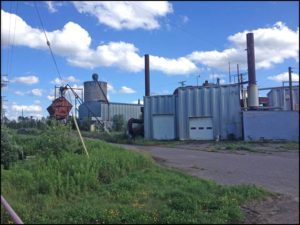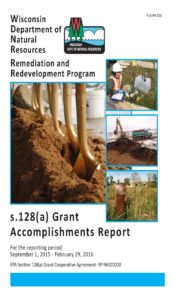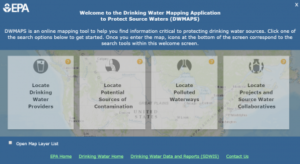RR-987 relating to post-closure modifications, the review process and applicable fees is now final and available for viewing. Contact Jane Lemcke with any questions about this document.
Archives
Wisconsin DNR Receives EPA Coalition Assessment Grant
The DNR’s RR Program will continue to help communities assess their brownfield sites with the addition of a $600,000 grant from the US EPA’s Assessment, Revolving Loan Fund and Cleanup (ARC) grant program. The DNR, in partnership with the Wisconsin Brownfields Coalition (WBC), is one of four Wisconsin entities to receive an FY16 ARC grant, allowing the agency to continue providing assistance to communities through the Wisconsin Assessment Monies (WAM) program. The WAM program provides no-cost environmental assessments at sites that are poised for cleanup and redevelopment. The WBC includes the DNR and all nine Wisconsin Regional Planning Commissions.
In the EPA press release, Administrator Gina McCarthy says, “These grants will empower communities to transform idle, languishing lands into vibrant hubs for business, jobs, and recreation. It’s all about empowering that initial funding, and sparking that first conversation to set stalled sites on a path to smart, safe redevelopment that directly benefits communities.”
UW-Whitewater Report Shows Positive Impacts on Distressed Areas and Small Towns
 An article in Renewal and Redevelopment highlights some impressive numbers from the UW Whitewater report, “The Economic and Fiscal Impact of Wisconsin’s Brownfields Investments” particularly as it relates to small communities and distressed areas. The article points out that economically disadvantaged communities received more assistance than more prosperous areas in the state. More than half of assisted sites were in census tracts with a lower median household income than the state as a whole.
An article in Renewal and Redevelopment highlights some impressive numbers from the UW Whitewater report, “The Economic and Fiscal Impact of Wisconsin’s Brownfields Investments” particularly as it relates to small communities and distressed areas. The article points out that economically disadvantaged communities received more assistance than more prosperous areas in the state. More than half of assisted sites were in census tracts with a lower median household income than the state as a whole.
The investment of cleanup and redevelopment of brownfields has also had an impact on small Wisconsin communities. Small towns with fewer than 15,000 people can be greatly impacted by a blighted property. The redevelopment of an abandoned site can help bring a community back to life.
The UW-Whitewater study was prepared by the University’s Fiscal and Economic Research Center for the Brownfields Study Group and the Wisconsin Economic Development Institute.
FY 2016 RR Program 128(a) Mid-Year Report Complete
 The RR Program’s mid-year report to US EPA, which details outputs and outcomes funded by a federal grant, is now available for review. The Section 128(a) Grant Mid-Year Report, for the reporting period of September 1, 2015 to February 29, 2016, highlights work completed in the first half of the funding year. Since 2003, the RR Program has consistently and efficiently used these funds under a cooperative agreement with the US EPA to enhance state efforts with brownfields cleanup and redevelopment. Previous reports can be found on the Brownfields Program web page.
The RR Program’s mid-year report to US EPA, which details outputs and outcomes funded by a federal grant, is now available for review. The Section 128(a) Grant Mid-Year Report, for the reporting period of September 1, 2015 to February 29, 2016, highlights work completed in the first half of the funding year. Since 2003, the RR Program has consistently and efficiently used these funds under a cooperative agreement with the US EPA to enhance state efforts with brownfields cleanup and redevelopment. Previous reports can be found on the Brownfields Program web page.
BOTW Database Has Documents for Download
 Did you know there are over 30,000 documents available for viewing and downloading on the Bureau for Remediation and Redevelopment Tracking System (BRRTS) on the Web (BOTW) database? BOTW is DNR’s online, public database that provides information about contaminated properties and other activities related to the investigation and cleanup of contaminated soil or groundwater in Wisconsin.
Did you know there are over 30,000 documents available for viewing and downloading on the Bureau for Remediation and Redevelopment Tracking System (BRRTS) on the Web (BOTW) database? BOTW is DNR’s online, public database that provides information about contaminated properties and other activities related to the investigation and cleanup of contaminated soil or groundwater in Wisconsin.
The DNR’s RR Program is adding new documents daily and working toward the goal of having the major reports, approvals and letters for all clean-up case files available online. Contact one of our Regional Environmental Program Associates (EPA) before making any plans or appointments to visit an office to review a file. There is a chance it is now available electronically.
US EPA Releases Online Mapping Tool to Help Protect Drinking Water Sources

Welcome page of DWMAPS displays search tools for users to find information about drinking water sources.
This robust, online mapping tool provides the public, water system operators, state programs, and federal agencies with critical information to help them safeguard the sources of America’s drinking water.
The DWMAPS – the Drinking Water Mapping Application to Protect Source Waters – allows users to learn about their watershed and understand more about their water supplier. The DWMAPS also allows users to see if sources of their drinking water are polluted and if there are possible sources of pollution that could affect their community’s water supply. The tool can even guide users to ways they can get involved in protecting drinking water sources in their community.
For more information and to access the map visit http://www.epa.gov/sourcewaterprotection/dwmaps.
RR Program Successes Highlighted in Agency Report
Take a bow, RR Program, your FY2015 successes and milestones are front and center in the latest Annual Report from DNR’s Air, Waste, and Remediation and Redevelopment (AWaRe) Division. The 29-page report examines and highlights program successes in customer service, new laws and regulations, emerging and ongoing issues, and measuring program performance.
During the reporting period, the RR Program celebrated its 20th anniversary. Since 1995, staff have worked with partners across the state, helping to clean up more than 15,000 brownfield properties and returning more than 20,000 acres back into productive use. The program marked the anniversary by continuing to work with our external advisory partner, the Wisconsin Brownfields Study Group, to create its 2015 Report – Investing in Wisconsin, which outlines proposals that will make a strong program even better.
Other RR notables in the Division Report include updates on major redevelopments in the Fox Valley and Madison, RR efforts to help clean up the former Badger ammo plant, and outreach achievements that help keep our partners and stakeholders informed and involved.
The Division’s commitment to service excellence was demonstrated by the fact that 97% of our customers who completed our survey indicated they were very satisfied or satisfied with the service they received from staff.
This is the AWaRe Division’s final annual report. The Division has merged with several DNR water programs and has formed the new Environmental Management Division.
UW-Whitewater Report Identifies Big Benefits from Brownfield Reclamation
Since 1998, Wisconsin has invested $121.4 million in the remediation of 703 contaminated properties, according to a recent UW-Whitewater study. The study says this investment leveraged tens of millions of dollars in local and federal incentives, and recouped nearly $1.8 billion from enhanced economic activity. This is a 14-fold return on investment, on top of the public health and environmental benefits generated by these cleanup projects.
The 703 projects that received state assistance are a small, but important, portion of the 15,000-plus state properties that have been cleaned up and put back into productive use over the past 20 years. These brownfield properties were once some of the toughest projects to tackle. They were dilapidated, destitute and, often, significantly contaminated. These properties needed a public push to get going.

The UW-Whitewater study, prepared by the University’s Fiscal and Economic Research Center for the Brownfields Study Group and the Wisconsin Economic Development Institute, calculates that local governments in Wisconsin gain $88.5 million annually from redeveloped brownfields.
The report shows that $1.00 of state funding for brownfields projects leverages $27.25 in total economic growth funding. In other words, $121.4 million from the state has generated $3.3 billion in direct total investment. The report also identified 29,883 direct new and retained permanent jobs related to completed projects in the 703 studied, and says another 9,107 jobs are planned at projects still underway.
